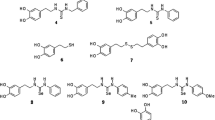Abstract
The study investigated the relationship between lipid peroxidation and enzyme inactivation in rat hepatic microsomes and whether prior inactivation of aldehyde dehydrogenase (ALDH) exacerbated inactivation of other enzymes. In microsomes incubated with 2.5 μM iron as ferric sulfate and 50 μM ascorbate, ALDH, glucose-6-phosphate (G6Pase) and cytochrome P450 (Cyt-P450) levels decreased rapidly and concurrently with increased levels of thiobarbituric acid-reactive substances. Microsomal glutathioneS-transferase and nicotinamide adenine dinucleotide phosphate-cytochromec reductase were little affected during 1 hr of incubation. Addition of reduced glutathione partially protected, andN,N′-diphenyl-p-phenylenediamine and butylated hydroxytoluene completely protected microsomes against inactivation of ALDH, G6Pase and Cyt-P450, as well as lipid peroxidation induced by iron and ascorbate. ALDH was more susceptible than G6Pase to inactivation by iron and ascorbate, and was thus an excellent marker for oxidative stress. Inhibition of ALDH by cyanamide injection of rats exacerbated the inactivation of G6Pase in microsomes incubated with 0.1 mM, but not 25 μM 4-hydroxynonenal (4-HN). 4-HN did not stimulate lipid peroxidation. Thus, 4-HN may play a minor role in microsomal enzyme inactivation. In contrast, lipid, peroxyl radicals play an important role in microsomal enzyme inactivation, as evidenced by the prevention of both lipid peroxidation and enzyme inactivation by chain-breaking antioxidants.
Similar content being viewed by others
Abbreviations
- Aa:
-
ascorbic acid
- ALDH:
-
aldehyde dehydrogenase(s)
- BHT:
-
butylated hydroxytoluene
- Cyt-c-Rx:
-
cytochromec reductase
- Cyt-P450:
-
cytochrome P450
- DPPD:
-
N,N′-diphenyl-p-phenylenediamine
- EDTA:
-
disodium ethylenedinitrilotetraacetate
- GSH:
-
reduced glutathione
- G6Pase:
-
glucose-6-phosphase
- GSHS-Tr:
-
glutathioneS-transferase
- 4-HN:
-
4-hydroxynonenal
- TBARS:
-
thiobarbituric acid-reactive substances
References
Tappel, A.L. (1973)Fed. Proc. 32, 1870–1875.
Davies, K.J.A. (1988) inCellular Antioxidant Defense Mechanisms (Chow, C.K., ed.) Vol. 2, pp. 27–40, CRC Press, Boca Raton.
Poli, G., Biasi, C.F., Leonarduzzi, G., Comoglio, A., Albano, E., and Dianzani, M.U. (1989)Adv. Biosci. 76, 73–81.
Esterbauer, H. (1985) inFree Radicals in Liver Injury (Poli, G., Cheeseman, K.H., Dianzani, M.U., and Slater, T.F., eds.), pp. 29–47, IRL Press, Oxford.
Brattin, W.J., Glende, Jr., E.A., and Recknagel, R.O. (1985)J. Free Radicals Biol. Med. 1, 27–38.
Eckl, P., and Esterbauer, H. (1989)Adv. Biosciences 76, 141–157.
Witz, G. (1989)Free Radical Biol. Med. 7, 333–349.
Haenen, G.R.M.M., Tsoi, J.N.L.T.T., Vermeulen, N.P.E., Timmerman, H., and Bast, A. (1987)Arch. Biochem. Biophys. 259, 449–456.
Koivula, T., and Koivusalo, M. (1975)Biochim. Biophys. Acta 397, 9–23.
Nakayasu, M., Mihara, K., and Sato, R. (1978)Biochem. Biophys. Res. Commun. 83, 697–703.
Hjelle, J.J., Grubbs, J.H., Beer, D.G., and Petersen, D.R. (1981)J. Pharmacol. Exp. Therapeu. 219, 821–826.
Mitchell, D.Y., and Petersen, D.R. (1987)Toxicol. Appl. Pharmacol. 87, 403–410.
Mitchell, D.Y., and Petersen, D.R. (1989)Arch. Biochem. Biophys. 269, 11–17.
Hu, M.-L., Frankel, E.N., Leibovitz, B.E., and Tappel, A.L. (1989)J. Nutr. 119, 1574–1582.
Beuge, J.A., and Aust, S.D. (1978)Methods Enzymol. 52, 301–310.
Harper, A.E. (1963)Methods of Enzymatic Analysis (Bergmeyer, H.U., ed.), pp. 788–792, Academic Press, New York.
Masters, B.S.S., Williams, Jr., C.H., and Kamin, H. (1967)Methods Enzymol 13, 565–574.
Omura, T., and Sato, R. (1964)J. Biol. Chem. 239, 2370–2378.
Habig, W.H., Pabst, M.J., and Jakoby, W.B. (1974)J. Biol. Chem. 249, 7130–7139.
Thomas, P.D., and Poznansky, M.J. (1990)J. Biol. Chem. 265, 2684–2691.
Itoh, F., Minamide, Y., Horie, T., and Awazu, S. (1989)Lipids 24, 905–908.
Nordlie, R.C., and Sukalski, K.A. (1985) inThe Enzymes of Biological Membranes (Martonosi, A.N., ed.) Vol. 2, pp. 349–398, Plenum Press, New York.
Dillard, C.J., Hu, M.-L., and Tappel A.L. (1991)Free Radical Biol. Med. 10, 51–60.
Morgenstern, R., and Depirre, W. (1983)Eur. J. Biochem. 134, 591–597.
Ando, M., and Tappel, A.L. (1985)Chem.-Biol. Interact. 55, 317–326.
Speth, M., Baake, N., and Schulze, H.-U. (1989)Arch. Biochem. Biophys. 275, 202–214.
Woenkhaus, C., Bieber, E., and Jeck R. (1987) inEnzymology and Molecular Biology of Carbonyl Metabolism (Weiner, H., and Flynn, T.G., eds.), pp. 53–65, Alan R. Liss, New York.
Lame, M.W., and Segall, H.J. (1987)Chem.-Biol. Interact. 62, 59–75.
Benedetti, A., Casini, A.F., Ferrali, M., and Comporti, M. (1979)Biochem. Pharmacol. 28, 2909–2918.
Author information
Authors and Affiliations
About this article
Cite this article
Hu, ML., Tappel, A.L. Glutathione and antioxidants protect microsomes against lipid peroxidation and enzyme inactivation. Lipids 27, 42–45 (1992). https://doi.org/10.1007/BF02537057
Received:
Revised:
Accepted:
Issue Date:
DOI: https://doi.org/10.1007/BF02537057




